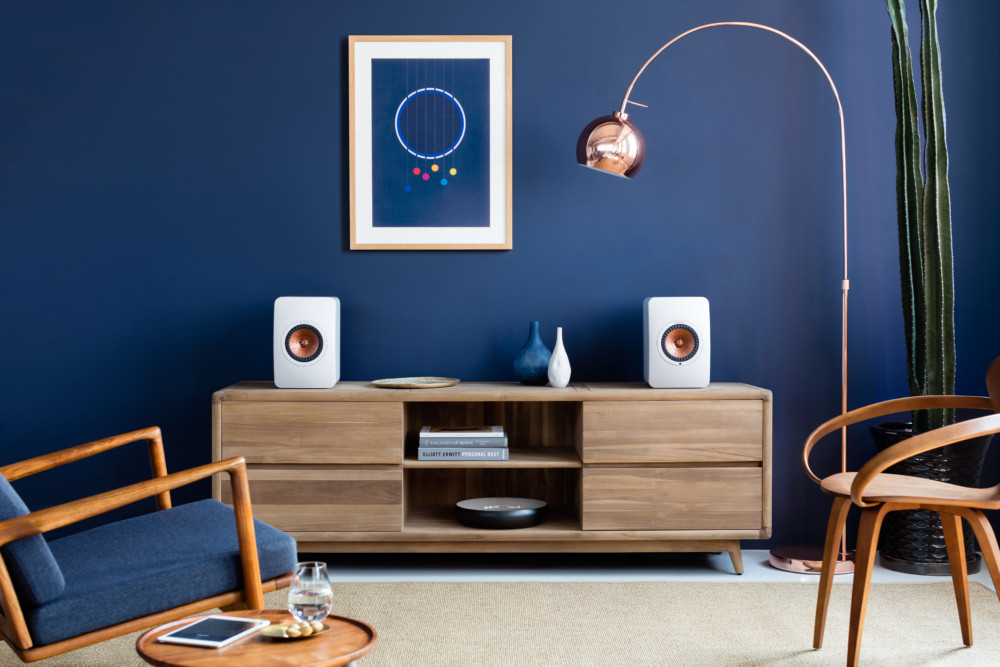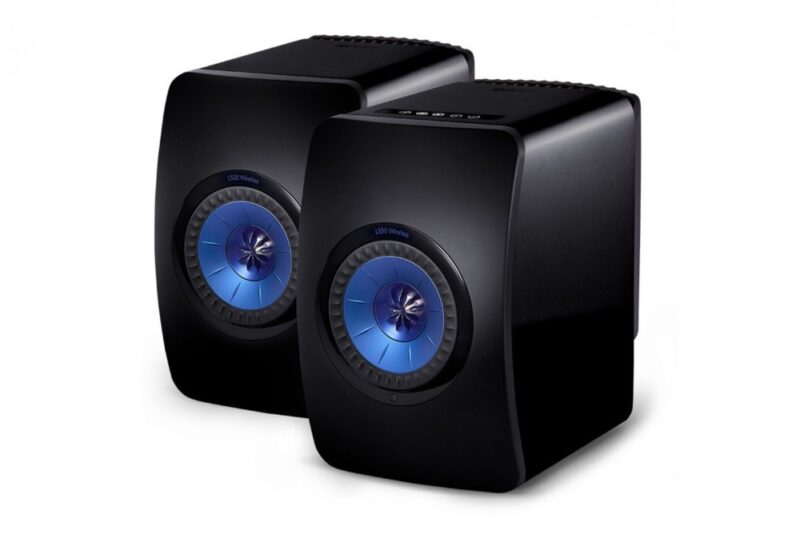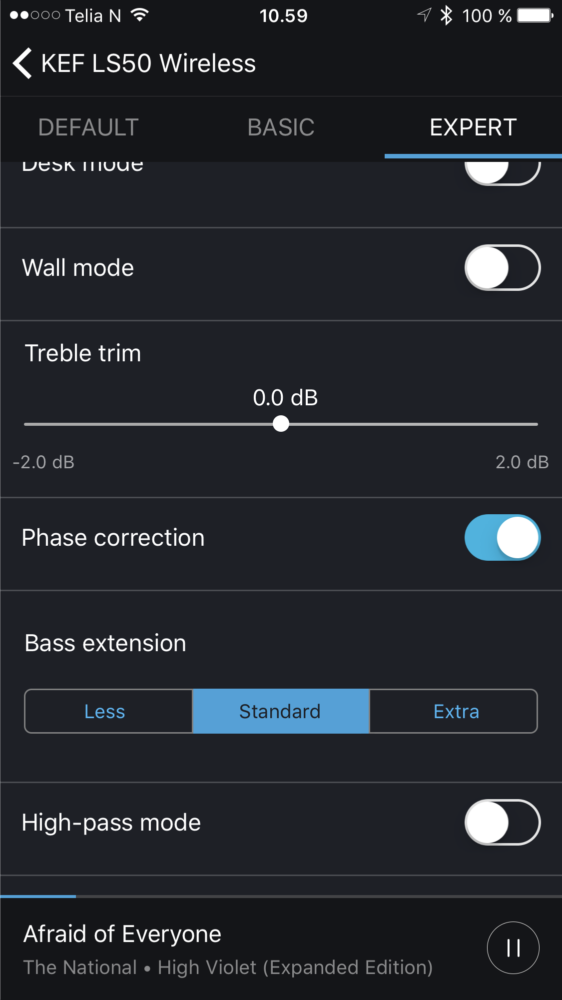Scepticism towards wireless speakers is understandable. In our tests, we have learned that there are often compromises in sound quality and usability. So if someone is disappointed with wireless speakers, we get it.
There are always exceptions. Dynaudio’s Xeo-Series and ELAC’s AIR loudspeakers are examples of successful speakers with regards to sound quality.
Unfortunately, the choice of wireless speakers at the same quality is severely limited.
But that was before we tested KEF LS50 Wireless.
Don’t think of these as a pair of KEF LS50 with wireless connection. This is something quite different. The speakers are based on the award winning LS50. Actually, one of our favourite speakers, but the inside of the chassis is entirely new.
The regular LS50 is a 30 cm tall two-way bookshelf speaker, which plays better than most similar speakers we’ve tested. The wireless edition uses the same unique (!) Uni-Q driver, with the treble located in the centre of a 13 cm aluminium membrane made of a magnesium alloy.
The coaxial driver construction provides a more uniform scatter pattern and zero time delay between frequencies. It works great on LS50 and KEF’s R series and Reference series. There is no reason why it shouldn’t work on the wireless edition.
With this, you don’t need anything but a couple of power outlets.
Think of them as a stereo for the modern home. Plug the TV into the optical input, stream the music wirelessly with Bluetooth, and forget the rest.
One push of the remote control or at the top of the right speaker is enough. Then just pull out the mobile phone and play some music.
Setup
You can really put them where you want. Without regard to “hifi-stuff”, because KEF’s engineers have made sure to make the loudspeaker adaptable. Do you want them on the IKEA shelf? Not a problem. Perhaps on the desktop? On stands? The loudspeaker can be programmed with a keystroke so that it adapts to the environment in which it is located. For example, when it is placed near the back wall.
But not everything is simple.
When you first connect them, plug them to a power outlet and connect the loudspeaker using the supplied ethernet cable (this is actually an advantage), you have to download the speaker app. You use the app to connect the loudspeaker to the wireless network at home, to adjust settings like the bass and treble, and to play music.
When Wifi is selected as input (you can also use the supplied remote control), you can grant the loudspeaker access to your music library via UPnP. Provided that this is already shared on your wireless network. Otherwise, you must to go to your computer and grant it access to the music on your hard drive.
Alternatively, you can just stream with Bluetooth, which I believe most people choose to do. This is indeed a complex product and it may seem overwhelming the first time you set up such an advanced loudspeaker.
If you are looking for Spotify Connect or Tidal integration, this is not currently available from the LS50 Wireless. You must set this up yourself, or stream via a USB from the laptop, or from a Spotify or Tidal app on your mobile phone.
A little technique
Everything you need is built into the speaker. You do not need to connect anything other than the above mentioned ethernet cable that goes between the speakers. It is a solution KEF has chosen because it is easier to synchronise music between the speakers with a physical connection than with a wireless one.
Each driver, i.e. the two in the coaxial construction, is run by each of its amplifiers. An analogue amplifier at 30 W powers the treble, while a 200 W class D amplifier powers the bass.
They are controlled by a digital processor that divides the signal between the drivers, and continuously corrects time differences, so there is no lag between them.
There is a digital converter for each of the drivers in each speaker. It works with 24-bit word length at 192 kHz, and supports high-resolution music files. In other words, files of higher quality than MP3 files.
Equaliser
The loudspeakers have four settings that are suitable for different positions. They are operated with four buttons on the back, Desk, Stand, Wall and Free Space . They affect the balance of the sound, so you won’t get excessive bass if the loudspeakers are against the wall next to the TV.
The app allows you to make multiple changes. Like adjusting the treble level, phase or bass range. It can be set to more or less deep bass, in addition to standard. If you plug in a sub-woofer, you can set the splitting frequency between the sub and loudspeakers in the app.
Sound quality
There are plenty of ways you can get optimal sound from these small loudspeakers. When everything is set up, you can expect to be truly blown away.
They play amazingly, and delivers a warm, rich soundscape with more deep base than most people are used to from small speakers. The advanced percussion that drives the songs on Tinariwen’s new album, Tiwàyyen, pounds away on the parquet floor without it sounding messy or undefined. The guitars appear crystal clear in the large soundscape, and the dynamic contrast is impeccable.
The air is lacking in treble on Renée Fleming’s collection of opera, but it does help to slightly crank up the treble in the app. It also includes the timbre of the string instruments, which I got to sound clearer in the mid-tones, when the treble was increased slightly. It also helped in Hannah Reid’s vocals in London Grammar. The new single Rooting For You gave me instant goose bumps from the neck down, and the piano tones sounded like shining pearls in the background. Truly stunning.
You quickly forget the loudspeakers, and you can easily get swept away with the music in a different way than usual. Mind you, this is with wireless speakers.
KEF’s strength lies in a highly well-balanced design, with thoughtful solutions, resulting in a remarkably successful soundscape without hidden hindrance. They have a beautiful focus without it sounding too sharp, the bass has total control without being exaggerated, and the sound is worm and rich without sounding woollen.
If you want to get wireless streaming and even better sound, two Devialet Phantom speakers is the answer, but the price will be significantly higher.
The best for now
The wireless edition of KEF LS50 is really better than the original. Admittedly, it costs twice as much, but it is worth it because it is easier to get it to play optimally, and then it sounds better than the wired edition from 2013. I can’t think of any better wireless speakers for most people. Not for those who have above average interest in music anyway, and who won’t flinch at the price tag.

We think
Beautiful sound and convenient loudspeaker for those who stream a lot. Excellent connectivity and you can adapt the sound to the room. May seem complicated to set up, some deficient app control without Spotify or Tidal being integrated.
23990 €
Specifications
Type: Wireless speaker
Bass: 130 mm magnesium/aluminium membrane
Treble: 25 mm aluminium treble
Sound pressure: 106 dB
Connections: Wifi, Bluetooth, optically digital, USB, analogue stereo, Ethernet, subwoofer
Dimensions/weight: 30 x 20 x 30.8 cm/10 kg
Other: Black, white, grey



